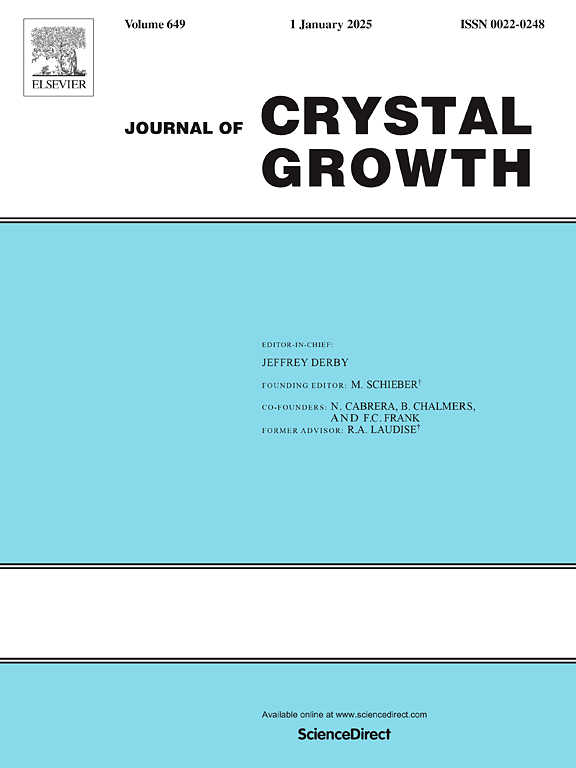The suppression of volatilization via high pressure during melt crystal growth: Analysis via two models of the optical floating zone
IF 2
4区 材料科学
Q3 CRYSTALLOGRAPHY
引用次数: 0
Abstract
We investigate the role of ambient pressure on volatilization during melt crystal growth using the high-pressure optical floating zone (OFZ) as a prototypical model. Species transport is incorporated into a previously-developed, thermal-capillary model which includes the effects of energy and momentum transport while computing the shape of the zone meniscus, melting front, and solidification front. Results from this model show that pressure monotonically decreases volatilization from the melt zone into the ambient gas and that species transport is both inhibited via diffusion and enhanced via convection as pressure increases. A lumped-parameter model corroborates these findings and clarifies the interaction between diffusion and convection using boundary-layer theory. While increasing pressure always suppresses volatilization, the concurrent strengthening of gas-phase flows with pressure diminishes its effects. For the OFZ system studied here, the evaporative flux of volatile species from melt scales nonlinearly with pressure as , which is greater than the expected scaling of when gas-phase convection is unimportant.
熔体晶体生长过程中高压对挥发的抑制:通过光学浮区的两种模型进行分析
我们以高压光学浮区(OFZ)为原型模型,研究了环境压力对熔体晶体生长过程中挥发的作用。在计算区域半月板、熔化锋和凝固锋的形状时,将物质输运纳入先前开发的热毛细管模型,该模型包括能量和动量输运的影响。该模型的结果表明,压力单调地减少了熔体向周围气体的挥发,随着压力的增加,物质的传输既通过扩散受到抑制,又通过对流得到加强。一个集总参数模型证实了这些发现,并利用边界层理论澄清了扩散和对流之间的相互作用。虽然增加压力总是抑制挥发,但气相流动随压力同时增强会减弱其作用。对于本文研究的OFZ体系,熔体挥发性物质的蒸发通量随压力呈非线性缩放,为Ji ~ P−2/5,当气相对流不重要时,该比例大于Ji ~ P−1的预期缩放。
本文章由计算机程序翻译,如有差异,请以英文原文为准。
求助全文
约1分钟内获得全文
求助全文
来源期刊

Journal of Crystal Growth
化学-晶体学
CiteScore
3.60
自引率
11.10%
发文量
373
审稿时长
65 days
期刊介绍:
The journal offers a common reference and publication source for workers engaged in research on the experimental and theoretical aspects of crystal growth and its applications, e.g. in devices. Experimental and theoretical contributions are published in the following fields: theory of nucleation and growth, molecular kinetics and transport phenomena, crystallization in viscous media such as polymers and glasses; crystal growth of metals, minerals, semiconductors, superconductors, magnetics, inorganic, organic and biological substances in bulk or as thin films; molecular beam epitaxy, chemical vapor deposition, growth of III-V and II-VI and other semiconductors; characterization of single crystals by physical and chemical methods; apparatus, instrumentation and techniques for crystal growth, and purification methods; multilayer heterostructures and their characterisation with an emphasis on crystal growth and epitaxial aspects of electronic materials. A special feature of the journal is the periodic inclusion of proceedings of symposia and conferences on relevant aspects of crystal growth.
 求助内容:
求助内容: 应助结果提醒方式:
应助结果提醒方式:


